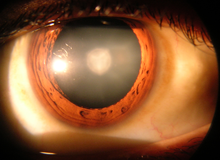Cataract
A cataract is when the lens of the eye gets cloudy. It is a treatable medical condition. Cataracts can cause short-sightedness (myopia), which means you cannot see things in the distance but can see things up close.

If not fixed by surgery, some types of cataracts will cause blindness (which means you cannot see anything at all). In a simple operation, the old lens can be replaced by a new plastic one. Many thousands of people have had this operation.
Signs and symptoms
changeCataracts develop gradually over time, so symptoms may not be immediately noticeable. However, as the condition progresses, the following signs and symptoms may become apparent:
- Cloudy or Blurry Vision: This is one of the most common symptoms of cataracts. Vision may become increasingly cloudy, hazy, or blurry, making it difficult to see clearly.
- Sensitivity to Light: Individuals with cataracts may experience increased sensitivity to bright lights, glare from headlights, lamps, or sunlight.
- Fading or Yellowing of Colors: Colors may appear faded or less vibrant than usual. Some people with cataracts also experience a yellowing or browning of colors.
- Poor Night Vision: Cataracts can cause difficulty seeing in dim or low-light conditions, which may result in problems with night driving or navigating in darkened rooms.
- Frequent Changes in Eyeglass Prescription: As cataracts progress, changes in vision may necessitate frequent changes in prescription eyeglasses or contact lenses.
- Double Vision: Cataracts can cause double vision in one eye, which may disappear when the affected eye is closed.
- Halos Around Lights: Some individuals with cataracts may see halos or circles around lights, particularly at night.
- Difficulty with Reading and/or Watching Television: Cataracts can make it challenging to focus on close-up tasks like reading or watching television.
- Increased Near-Sightedness (Myopia) or Far-Sightedness (Hyperopia): As the lens becomes increasingly clouded, it may cause changes in refractive error, leading to near-sightedness or far-sightedness.[1]
It's important to note that these symptoms can vary in severity and may affect each individual differently. If you're experiencing any of these symptoms, it's crucial to consult an eye care professional for a comprehensive eye examination and proper diagnosis.
Causes of Cataract
changeCataracts develop when the clear lens of the eye becomes cloudy, impairing vision. Several factors can contribute to the formation of cataracts. These include:
- Age: Age-related changes in the lens structure are the most common cause of cataracts. As people age, the proteins in the lens can clump together, causing cloudiness and opacity.
- UV Radiation: Prolonged exposure to ultraviolet (UV) radiation from sunlight over the years can increase the risk of developing cataracts. Protecting your eyes from UV rays with sunglasses that block UVA and UVB rays may help reduce this risk.
- Diabetes: People with diabetes are at a higher risk of developing cataracts due to changes in the metabolism of glucose within the eye, which can lead to clouding of the lens.
- Smoking and Alcohol Consumption: Smoking and excessive alcohol consumption have been linked to an increased risk of cataracts. The exact mechanisms are not fully understood, but they may contribute to oxidative stress and damage to the lens.
- Genetics: Genetics can play a role in cataract development. Some people may inherit a predisposition to cataracts or have genetic conditions that increase their risk.
- Eye Trauma or Injury: Trauma to the eye, such as blunt force trauma or penetrating injuries, can damage the lens and increase the risk of developing cataracts.
- Certain Medications: Long-term use of certain medications, such as corticosteroids or medications used to treat conditions like psoriasis or rheumatoid arthritis, may increase the risk of cataracts.
- Other Medical Conditions: Certain medical conditions, such as obesity, hypertension (high blood pressure), and previous eye surgery, can increase the risk of cataracts.
- Congenital Factors: Some infants are born with cataracts or develop them in childhood due to genetic factors, infections during pregnancy, or other congenital conditions.
Understanding the potential causes of cataracts can help individuals take preventive measures and make lifestyle choices that may reduce their risk or delay the onset of cataracts. Regular eye exams and consultations with an eye care professional are important for early detection and management of cataracts.
References
change- ↑ "Cataract Surgery - Diagnosis, Procedure Recovery and Benefits". www.pristyncare.com. Retrieved 2024-02-27.
Other websites
change- https://www.mayoclinic.org/diseases-conditions/cataracts/symptoms-causes/syc-20353790
- https://www.pristyncare.com/treatment/cataract/